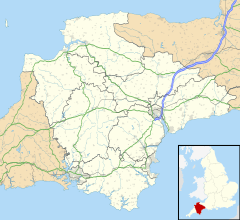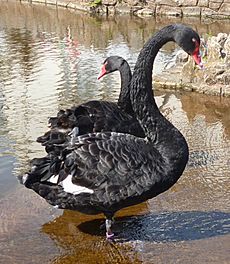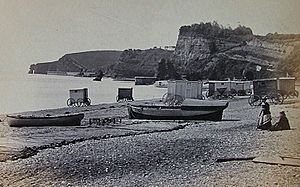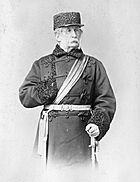Dawlish facts for kids
Quick facts for kids Dawlish |
|
|---|---|
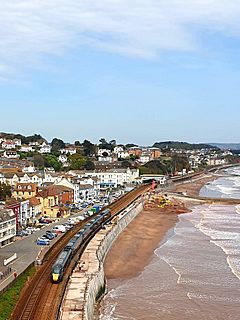 The seafront at Dawlish |
|
| Population | 15,257 (2021 Census) |
| OS grid reference | SX963767 |
| Civil parish |
|
| District |
|
| Shire county | |
| Region | |
| Country | England |
| Sovereign state | United Kingdom |
| Post town | DAWLISH |
| Postcode district | EX7 |
| Dialling code | 01626 |
| Police | Devon and Cornwall |
| Fire | Devon and Somerset |
| Ambulance | South Western |
| EU Parliament | South West England |
| UK Parliament |
|
Dawlish /ˈdɔːlɪʃ/ is a seaside resort town and civil parish in the Teignbridge district in Devon, England. It is located on the south coast of England at a distance of 12 miles (19 km) from the city of Exeter and a similar distance from the town of Torquay. The 2011 Census population was recorded at 11,312, rising to 13,355 in a 2019 estimate. Dawlish had grown in the 18th century from a small fishing port into a seaside resort, as had its near neighbour, Teignmouth, in the 19th century.
Contents
Description
Dawlish is located at the outlet of a small river, Dawlish Water (also called The Brook), between Permian red sandstone cliffs, and is fronted by a sandy beach with the South Devon Railway sea wall and the Riviera Line railway above. Behind this is a central public park, The Lawn, through which Dawlish Water flows.
Immediately to the south-west of Dawlish is a headland, Lea Mount, with Boat Cove at its foot and Coryton Cove, the furthest part of the beach accessible by the seawall path, behind it. To the north-east, via the beach or seawall, the coast can be followed some 2 km to Langstone Rock and the resort of Dawlish Warren beyond, although this path is blocked at extreme high water.
Dawlish is also known for its black swans (Cygnus atratus), introduced from Western Australia, which live with other exotic waterfowl in a small urban sanctuary on Dawlish Water.
Toponymy
The name Dawlish derives from a Welsh river name meaning black stream. There was also a Roman translation of Dolfisc, meaning 'Dark river' and 'The Devils Water'. It was first recorded in 1044 as Doflisc. By 1086 it was Dovles; in 1302, Dovelish; and by 1468 it had become the more recognisable Dawlisshe.
History
Before Dawlish itself was settled, fishermen and salt makers came down from the higher ground where they lived, to take advantage of the natural resources available on the coast hereabouts. They built salterns to produce salt and stored it in sheds nearby. The unpredictable nature of the stream, Dawlish Water, during floods is likely to have led to nearby Teignmouth being the preferred site for salt-making, and the practice stopped at Dawlish during the Anglo-Saxon period (AD 400–1000).
The earliest settlement at Dawlish grew up almost a mile away from the coast, around the area where the parish church is today. There is evidence of early settlements at Aller Farm, Smallacombe, Lidwell and at Higher and Lower Southwood, where the ground would have been fertile and not subject to flooding.
The land that includes present-day Dawlish was granted by Edward the Confessor to Leofric, later the first Bishop of Exeter, in 1044. After the Norman Conquest, Leofric gave the land to the Diocese of Exeter, which held it until it was sold, in 1802.
Little of note happened at Dawlish until the end of the 18th century, when seaside locations on the south coast started to become popular with the wealthy, mainly caused by George III making Weymouth in Dorset his summer holiday residence from 1789. In May 1795, the antiquarian and topographer John Swete spent some time in Dawlish and reported that although not long ago it had been no more than a fishing village, and the best lodging house would not cost more than half a guinea per week, it was now so fashionable that "in the height of the season, not a house of the least consequence is to be hired for less than two guineas a week, and many of them rise to so high a sum as four or five."
In the first decade of the 19th century the land between the original settlement and the sea was "landscaped"; the stream was straightened, small waterfalls were built into it, and it was flanked by a broad lawn and rows of new houses: The Strand on the north side and Brunswick Place on the south. The entire layout survives remarkably unchanged today, despite severe damage caused by a torrent of water coming down Dawlish Water from the Haldon Hills on the night of 10 November 1810.
Also worth noting are Manor House and Brook House (both about 1800) and some of the cottages in Old Town Street surviving from the old village. Dawlish's transformation from a fishing settlement to a watering hole for Victorian celebrities is documented at the Dawlish Museum.
Brunel's railway
In 1830, Isambard Kingdom Brunel designed a railway, which operated on a pneumatic principle, using a 15-inch iron tube. One of the pumping stations was in this town. The line ran right along the seafront, but Brunel ensured that the line was carried across the mouth of the stream on a small granite viaduct, leaving access to the beach.
The atmospheric railway opened on 30 May 1846 and ran between Exeter St. Davids and Newton Abbot. The first passenger train ran in September 1847, but the project was besieged with problems mainly with the leather sealing valve, which after 12 months of use needed replacing at a cost of £25,000. South Devon Railway directors abandoned the project in favour of conventional trains: the last atmospheric train ran in September 1848.
Literary connections
After visiting Sidmouth in 1801, Jane Austen spent a long holiday at Dawlish in 1802, later complaining about its "particularly pitiful and wretched library". She mentioned it several times in her 1811 novel Sense and Sensibility. In Charles Dickens' Nicholas Nickleby (1838–39), the protagonist inherits a small farm near Dawlish. The novelist and poet Margaret Holford died in Dawlish on 11 September 1852, aged 84. .....
Notable people
- Thomas Vowler Short (1790–1872), academic and clergyman, & Bishop of Sodor and Man and Bishop of St Asaph.
- Field Marshal Sir John Michel (1804–1886), a British Army officer, served in the Crimean War & India.
- Herman Merivale (1806–1874), an English civil servant and historian.
- Robert J. Shuttleworth (1810–1874), an English botanist and malacologist.
- Colonel Sir Arthur George Hammond, (1843–1919), recipient of the Victoria Cross
- H. O. Arnold-Forster (1855–1909), a British politician and writer.
- Captain Henry Singleton Pennell (1874–1907), recipient of the Victoria Cross
- Igerna Sollas (1877–1965), a British zoologist, palaeontologist and geologist
- Aylward M. Blackman (1883–1956), an Egyptologist, who excavated in Egypt and Nubia, notably Buhen and Meir.
- Paul Britten Austin (1922–2005), author, translator, broadcaster, administrator and scholar of Swedish literature.
- Sir Adrian Frederick Melhuish Smith, PRS (born 1946), statistician and chief executive of the Alan Turing Institute
Transport
Railway
Dawlish railway station, situated in the town centre and next to the beach, is served by two train operating companies:
- Great Western Railway operates regular half-hourly stopping trains on a route between Exmouth, Exeter and Paignton. Some inter-city services between Plymouth, Paignton and London Paddington stop here, as well as some services between Cardiff, Bristol, Plymouth and Penzance.
- CrossCountry services between Manchester Piccadilly and Paignton stop here twice a day in each direction.
The line includes one of the most memorable stretches of British track for its natural environment, but at high cost; a constant battle with sea erosion makes it one of the dearest lines in the country to maintain. For example, a storm in 1974 washed away much of the station's down platform; also, in the UK storms of January–February 2014, waves brought down the sea wall and washed away a section of line, leaving the permanent way suspended.
The 2014 storm raised questions about the vulnerability of the South Devon Railway sea wall to storm damage and proposals were made to route Plymouth-bound rail services further inland, by re-opening the disused railway line via Okehampton and Tavistock, reopening the former Teign Valley Line or reviving a 1930s GWR project to construct the Dawlish Avoiding Line. In May 2019, Network Rail began a project to improve the sea defences along the sea wall at Marine Parade, south of the station, promising a wider, more accessible walkway with seating and lighting, and greater protection from the sea; it was completed on 3 July 2023.
Roads
The A379 road between Exeter, Teignmouth, Torbay, Dartmouth and Plymouth runs through the town, parallel to the railway line.
Buses
Buses in the town are operated predominantly by Stagecoach South West. Key routes are:
- 2 from Exeter to Newton Abbot
- 22 from Dawlish Warren to Torquay
- 186, which links the town centre, hospital and Sainsbury's to the main housing areas; this is operated by Country Bus (Newton Abbot).
Climate
Dawlish has a mild, oceanic climate bordering on a warm to cool Mediterranean climate, according to the Köppen climate classification, with low precipitation in the summer period and high rainfall in the winter. Often termed the "English Riviera" along with Teignmouth and Torbay, Dawlish rarely has snow or frost and grows outdoor subtropical plants such as palms, olives, bananas and lemons. Temperatures over 30C or under 0C are infrequent. It is one of the sunniest places in Britain, with an average of nearly 1800 hours a year. Despite more favourable conditions in the summer, the wet autumn and winter can bring copious amounts of rain, and when areas of low pressure move up the English Channel, easterly winds with dramatic storm surges and waves along the seafront.
Local produce
During the early and middle part of the 20th century, Dawlish became known for Devon Violets perfume. Hundreds of varieties were grown in market gardens surrounding the town. Violet escapees can be found growing wild across the area. Lately the town has become known for growing dianthus, freesias, daffodils, tomatoes and strawberries.
Retail and employment
Centred on The Strand, Queen Street, Brunswick Place and Park Road, Dawlish has typical retail facilities for a resort town with gift shops, cafes, a fishing tackle shop, beach/toy shops, bakeries, restaurants and pubs, haberdasheries, ice-cream shops, national chains and many independent retailers. Along Piermont Place, by Dawlish railway station and the seafront, are further ice-cream shops, a restaurant, a cafe and a sports-bar with outdoor seating areas. In recent years, a number of art, craft and antiques shops have opened. At the north-eastern end of the town there is a Sainsbury's supermarket with an Argos facility and a petrol station.
The largest employment sector in the town is health and social work (23 per cent), due to a large number of care homes, followed by accommodation and food services (20 per cent).
Religion
The town's places of worship:
- Hope Church (DCF)
- Dawlish Baptist Church
- Dawlish Methodist Church
- Dawlish Strand Church (United Reformed)
- St Agatha's Church (Roman Catholic)
- St Gregory's Church (Anglican)
- St Mark's Church (closed in 1974 and demolished)
Schools and education
The primary schools in Dawlish are Gatehouse Primary School, Westcliff Primary School and Orchard Manor School. Dawlish College (formerly Dawlish Community College) in Elm Grove Road is the main secondary school. Oakwood Court College is a specialist residential college based in Dawlish, with a satellite college in Torpoint.
Governance
Locally, Dawlish is governed by Dawlish Town Council, which is currently controlled by the Liberal Democrats, as is the next local-government layer above, Teignbridge District Council. Dawlish lies in the parliamentary constituency of Newton Abbot and is currently represented by Conservative MP Anne Marie Morris, who retained her seat at the 2019 general election.
Twinning
Dawlish is twinned with the Breton commune of Carhaix-Plouguer in France.
See also
 In Spanish: Dawlish para niños
In Spanish: Dawlish para niños


